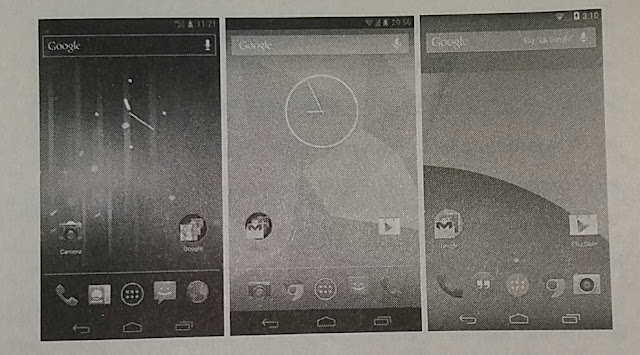1. Android version 1.0 was released on 23.09.2008.
2. Android version 1.1 was released on 09.02.2009.
3. Android version 1.5 Cupcake was released on 30.04.2009.
It is the first version to be released commercially and is also first named after the cake. This version of Android has just begun to add features that are commonly found today such as Widgets, Auto Rotate, and support for virtual keyboards from third parties. In this stage it can be said that Google is still trying to incorporate basic features.
4. Android version 1.6 Donut was released on 15.09.2009.
On Android Donut, smartphones get several additional features such as CDMA support, a text to voice engine, and a battery usage indicator. The version number that is not much different than before makes Android Donut more as a mini update.
5. Android version 2.0 Eclair was released on 26.10.2009.
There are quite a lot of changes compared to the initial Android version. In this update Google provides support and new features that function to make it easier for users. Android Eclair gets several new features that are mainly on the camera application by adding flash support, focus, to color effects. In this version Google also added a Live Wallpaper that is pretty cool at the beginning of its appearance.
 |
| Display Android Cupcake, Donut, and Eclair |
6. Android version 2.2 Froyo, released on 10.05.2010
In this version, Android experienced significant performance optimization and added with USB Tethering support. Wi-Fi Hotspots, and push notifications are very useful to date. Also in this version we can move the application to external storage if possible.
7. Android version 2.3 Gingerbread is classified as the most successful, released on 06.12.2010.
 |
Display Android Froyo and Gingerbread
|
The current operating system is specific to tablet devices. In this Honeycomb some useful features still survive today such as the System Bar, multi-core processor support, to the customizable Home screen. Android 3.0 Honeycomb at launch looks very futuristic and attracts a lot of attention.
 |
Display Android Honeycomb
|
9. Android version 4.0 Ice Cream Sandwich already supports Flash Player, released on 19.10.2011.
Google unifies smartphone and tablet devices and adds a more minimalistic interface. One of the interesting new features on this version of Android is Android Beam which allows fast data transfer using NFC.
10. Android version 4.1 Jelly Bean has advantages in battery, gesture navigation, and camera. Released 09.07.2012.
This version is more focused on improving performance and security. Most of the improvements in the Android version occur on the Android system itself. But there is one feature that really needs to be known, namely support 4K UHD resolution.
 |
Display of Ice Cream Sandwich, Jelly Bean, and Kitkat |
11. Android version 4.4 Kitkat released on 31.10.2013.
Focus on improving user experience and performance, especially on lower-class devices. Android 4.4 KitKat provides a minimum limit of available RAM for Android of 512 MB so that devices that have RAM below that are classified as low RAM devices. The newest features are:
》 Screen recording.
》 New Translucent UI system.
》 Improved notification access.
》 System-wide settings for closed captioning.
》 Performance improvement.
》 Activate Sprint Spark band 26 and band 41.
》 Repair vulnerabilities in Heartbleed / OpenSSL.
12. Android version 5.0 Lollipop released 17.10.2014.
It was the first time carrying a material design that is still a trend today. Its features are:
》 New design (Material).
》 Speed increase.
》 Increased battery life.
》 Repair video playback and password failure.
》 Support Multi SIM cards.
》 Shortcuts in Quick settings for Wi-Fi and Bluetooth.
》 Security if the device is lost or stolen.
》 Use of High Definition sound for the phone.
》 Increased stability performance.
13. Android version 6.0 Marshmallow was released on 28.05.2015.
It further strengthens what has been done by Google so far through Android Lollipop. Through this latest operating system, Google brings powerful features that are very useful such as:
》 Support USB Type-C.
》 Support fingerprint authentication (Fingerprint).
》 Battery life is further enhanced by Doze's battery consumption management.
Dashboard Permissions dashboard.
》 Access the UI Tuner System.
》 Support payment systems with Android Pay that collaborate with Fingerprint Authentication so that security is guaranteed.
》 Additional Google Now functions that don't just serve voice commands.
14. Android version 7.0 Nougat introduced 22.08.2016.
Provides improvements to the user experience to make it easier. The multi-window support feature is a major concern so users can use several applications simultaneously. There are also features that make operating system updates smoother and less noticeable when the device is not in use.
》 Multi-window support.
》 Reply directly to messages from the notification window or menu.
》 Display new notification panel and quick settings.
》 Enhanced Doze Mode (Doze Mode 2.0).
》 Menu between system settings.
 |
| Display of Lollipop, Marshmallow, and Nougat |
15. Android version 8.0 Oreo was officially released on 21.08.2017.
》 Android O is more focused on speed and efficiency.
》 Boot speed up 2X faster.
》 Picture in picture mode is more flexible than Android N.
》 Applications that are running in the background are tightened to save battery life.
》 The battery lasts longer.
》 Updated emojis and more.
 |
| Display Android Oreo |
The following is a table of the number of Android users up to October 2017. The highest order is Android Marshmallow, Lollipop, Nougat, and Kitkat. When we choose that the application will be used on Marshmallow, it will be ensured that the most users will not get many problems when running the application that we offer.
In addition to the Android version, what we are considering is the screen size used. Currently the most popular is the normal screen with xhdpi. Please check the image below.
 |
| Android users based on the version |
 |
| Android users by screen |
Read: https://knowledgefrans.blogspot.com/2020/02/basic-program.html?m=1




No comments:
Post a Comment